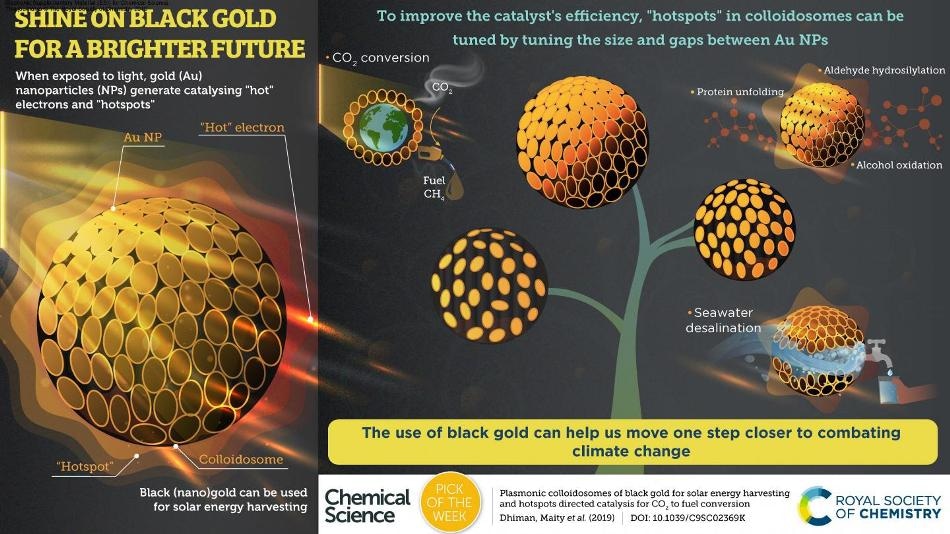Jul 4 2019
Global warming poses a serious hazard to Earth and living beings. The rise in the atmospheric CO2 level is one of the key reasons for global warming.
 Use of black gold can get us one step closer to combat climate change. (Image credit: Royal Society of Chemistry, Chemical Science)
Use of black gold can get us one step closer to combat climate change. (Image credit: Royal Society of Chemistry, Chemical Science)
The major origin of this CO2 is from the burning of fossil fuels in everyday life (vehicles, electricity, industry, etc.).
Scientists at TIFR have designed the solution phase synthesis of Dendritic Plasmonic Colloidosomes (DPCs) with changing interparticle distances between the gold nanoparticles (NPs) using a cycle-by-cycle growth method by enhancing the nucleation-growth step.
These DPCs absorbed the whole visible and near-infrared region of solar light because of interparticle plasmonic coupling and also due to the heterogeneity in the Au NP sizes, which changed golden gold material to black gold.
Black (nano) gold could catalyze the conversion of CO2 to methane (fuel) at atmospheric temperature and pressure, using solar energy. Furthermore, the researchers noticed the considerable effect of the plasmonic hotspots on the performance of these DPCs for the purification of seawater to drinkable water through temperature jump-assisted protein unfolding, steam generation, hydrosilylation of aldehydes, and oxidation of cinnamyl alcohol using pure oxygen as the oxidant.
This was ascribed to changing particle sizes and interparticle distances in these DPCs. The outcomes signify the synergistic impacts of EM and thermal hotspots and also hot electrons on DPCs performance. Therefore, it is possible to effectively employ DPCs catalysts as Vis-NIR light photo-catalysts, and it is also possible to design new plasmonic nanocatalysts for a broad variety of other chemical reactions using the idea of plasmonic coupling.
SERS (Surface-Enhanced Raman Spectroscopy) and Raman thermometry offered information about the electromagnetic and thermal hotspots and local temperatures which were found to be based on the interparticle plasmonic coupling. The role of the interparticle distances in the SPR (Surface Plasmon Resonance) of the material was corroborated by the spatial distribution of the localized surface plasmon modes by STEM-EELS plasmon mapping.
Therefore, in this research, by using the methods of nanotechnology, the scientists changed the golden gold to black gold, by varying the size and distances between gold nanoparticles. Just like the real trees, which exploit sunlight, CO2, and water to produce food, the developed black gold behaves like an artificial tree that uses water, sunlight, and CO2 to generate fuel, which can be used to power cars.
Specifically, black gold can also be used to transform seawater into drinkable water using the heat produced by black gold following the capture of sunlight.
This research is a way ahead to create “Artificial Trees,” which take up CO2 and convert it into fuel and valuable chemicals. Presently, the production rate of fuel is low; however, these issues can be resolved in the future. Soon, CO2 could be converted to fuel using sunlight at atmospheric condition, at a commercially viable scale and CO2 may subsequently become the major source of clean energy.